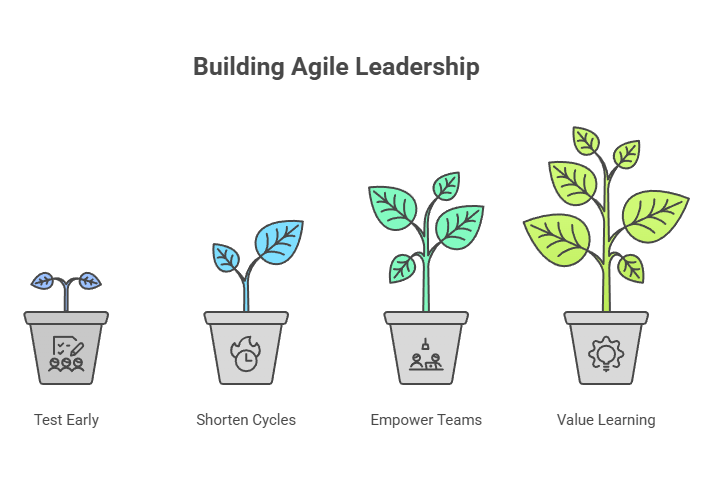Key Takeaways
- Agility Over Perfection: Speed of learning consistently outperforms perfect planning.
- Constraints Create Clarity: Limited resources sharpen focus and innovation.
- Lead by Learning: Curiosity and humility build stronger, more resilient teams.
- Redefine Risk: Progress often comes from small, safe experiments.
- Culture Starts at the Top: Leadership, not HR, sustains organizational trust.
The Leadership Mindset Behind Startup Speed
Startups move fast because they must. They make quick decisions, adapt daily, and treat learning as a form of progress. For larger organizations, that pace can seem chaotic, yet behind it lies something worth studying: leadership behaviors that balance clarity with experimentation.
At SentinelWave, a mid-sized firm, the leadership team found itself watching smaller competitors out-innovate them. Even with strong processes and technology, projects stalled. Teams waited for approvals instead of acting, and creative ideas often disappeared before reaching customers.
Their realization came slowly. The issue was not the process or tools. It was leadership confidence. Managers were coordinating tasks instead of guiding learning, leaving teams hesitant to take initiative.
This article explores how traditional organizations can learn from startup-style leadership by shifting from control to curiosity and from perfection to progress.
Why Startup Leadership Works
Startup leaders rarely depend on hierarchy to move work forward. Instead, they rely on clarity, shared ownership, and adaptability, leading through connection rather than control. Their success comes from learning fast and adjusting even faster.
How Leaders Apply This Mindset:
- Clarify Direction: Set clear goals that keep teams aligned and accountable.
- Empower Ownership: Trust teams to act within defined priorities.
- Prioritize Progress: Focus on learning outcomes over flawless plans.
- Build Connection: Strengthen relationships that support honest collaboration.
As the SentinelWave leadership team began their offsite meeting, the mood was cautious. Despite strong systems and clear processes, projects often stalled before reaching customers. “We were maintaining structure, not building momentum,” the operations director admitted.
The COO added, “We’ve built systems that make it hard for anyone to move without permission.” The CEO nodded. “Our teams follow the process, but they don’t feel empowered to lead through it.” The room fell silent for a moment as the realization settled in. The issue wasn’t strategy or process; it was confidence.
Startup-style leadership works because it treats clarity and curiosity as daily disciplines. When leaders focus on learning and shared accountability, they invite teams to move faster with purpose.
How to Lead With Agility in Structured Organizations
Agile leadership isn’t about removing structure; it’s about making it work smarter. Highly successful agile transformations typically delivered around 30 percent gains in efficiency, customer satisfaction, employee engagement, and operational performance. Real agility happens when leaders give teams space to test ideas, learn quickly, and adjust before locking into big decisions.
How Leaders Build Agility:
- Test Early: Pilot ideas in small, low-risk ways.
- Shorten Cycles: Use shorter planning windows for faster feedback.
- Empower Teams: Give cross-functional groups authority to act.
- Value Learning: View progress as a learning curve, not a checklist.
Not long into the session, conversation shifted to how long projects took to reach customers. “Learning early costs less than fixing late,” the COO remarked, drawing a few nods from around the table.

The CIO added, “We spend months trying to perfect an idea before we ever show it to a customer. That’s why we miss trends.” The room grew quiet as the comment sank in. The team began to see that their careful planning wasn’t reducing risk. It was slowing progress.
Agility grows when leaders create space for ideas to take shape before they’re complete. By valuing learning over perfection, even large organizations can build startup-like momentum. Innovation often appears when time, budget, and people are stretched to their limits.
Why the Best Leaders See Constraints as Catalysts
Startups see constraints not as limits but as clarity. With fewer resources, they make sharper choices, think creatively, and stay focused on what matters most. The pressure to do more with less pushes leaders to cut waste, prioritize value, and build momentum through discipline.
Turning Scarcity into Strategy:
- Simplify Focus: Concentrate only on the priorities that create value.
- Redirect Resources: Move time and funding toward high-impact work.
- Foster Ingenuity: Encourage creative problem-solving under pressure.
- Measure Value: Track learning and results, not activity volume.
As the morning went on, the discussion turned to resources. “We talk a lot about scaling,” said the finance director, “but maybe what we need is fewer projects, done better.” The CEO nodded. “We’ve been confusing activity with progress.”
Working within limits sharpens focus and strengthens discipline. When leaders view constraints as catalysts, they redefine how progress takes shape. That clarity often leads to the next challenge: learning how to approach risk not as a barrier, but as an essential part of growth.
Rethink Risk (It’s Not What You Think)
Most organizations see risk as something to avoid, but startups see it as a source of insight. Instead of waiting for certainty, they test ideas in small, safe steps and learn quickly from what happens next.
Turning Risk into Advantage:
- Distinguish Decisions: Identify which choices are reversible and which are not.
- Start Small: Pilot ideas to learn before scaling.
- Normalize Learning: Reward honesty about what does and doesn’t succeed.
- Use Data Early: Let evidence, not assumption, guide growth.
As the afternoon unfolded, the discussion turned to risk. “We treat every decision like it’s irreversible,” the CTO admitted. The general counsel agreed, noting that most choices weren’t high stakes.
Discussion turned to how they might separate high-impact decisions from those safe to test and adjust. Many began to see how the need for certainty was costing both speed and creativity.
Rethinking risk means replacing fear with feedback. When experimentation becomes a habit, decisions grow faster, smarter, and more inclusive. When risk becomes part of learning, leadership maturity follows naturally.
The shift from control to curiosity matters most in daily decisions. When leaders model small, visible learning moments, they build trust and openness. Over time, curiosity replaces certainty, and growth becomes the norm.
Why the Best Leaders Ask More Than They Answer
Strong leaders know they don’t need every answer to lead well. Instead, they stay curious, asking questions that spark insight and invite new ideas. When leadership is rooted in learning, teams become stronger, more creative, and more resilient.
At Watermark Learning, we often remind leaders that curiosity isn’t a gap to close but a strength to cultivate.
How to Lead by Learning:
- Asking Questions: Use curiosity to uncover patterns and insights.
- Sharing Lessons: Make learning visible across the organization.
- Modeling Openness: Admit what you don’t know to encourage honesty.
- Inviting Dialogue: Create safe spaces for thoughtful conversation.
By late afternoon, the room felt different. Leaders who once focused on process were now reflecting on how they learned together. The CHRO posed a simple question: “What if we began every leadership check-in by sharing what we’ve learned, not just what we’ve done?”
The CIO paused. “That would change the tone completely,” she said, as several heads nodded. The idea was simple but powerful; a way to make learning visible.
Learning is more than a task; it’s how leadership takes shape every day. When leaders stay curious, they show teams that growth is part of the job, not an extra step. Over time, that attitude shapes how people communicate, collaborate, and trust each other, the true foundation of culture.
Culture Is a Leadership Job, Not an HR Function
Culture grows through what leaders do every day, not through written policies or slogans. Each conversation, decision, and follow-through moment either strengthens or weakens trust. The leaders who recognize this create cultures where values aren’t just stated, they’re lived.
How Leaders Strengthen Culture:
- Promote Openness: Build clear, two-way channels for honest dialogue.
- Model Values: Live the behaviors you expect from others.
- Celebrate Integrity: Recognize moments that reflect shared values.
- Measure Trust: Treat transparency as a key performance indicator.
Near the close of the session, the topic shifted to transparency. “We’ve talked for years about wanting an open culture,” the CEO said, “but I’m not sure our actions show it.” The HR director agreed, noting that employees often waited for permission to speak up.
The group agreed that openness couldn’t live in HR or communication plans. It had to start with leadership, through curiosity, feedback, and example.
As the meeting ended, the tone changed. The conversation moved from analyzing problems to imagining what leadership could become. No one had every answer, but everyone left with purpose and belief in meaningful change.
When leaders treat culture as part of their everyday work, engagement becomes a shared responsibility. The real impact comes when those daily actions turn into lasting habits that shape how people lead, collaborate, and grow together.
Turning Leadership Lessons Into Daily Habits
Great leadership habits do not grow in workshops alone. They take root through daily behavior and consistent reinforcement. The most effective leaders treat every conversation, meeting, and project as a chance to model the culture they want to see.
Leading with a Startup Mindset:
- Host Quick Reviews: Replace long meetings with short “what we learned” sessions.
- Revisit Priorities: Keep key goals visible and adjust them as context changes.
- Share Learning Stories: Celebrate moments when reflection led to better results.
- Ask for Feedback: Invite honest input on your leadership and decisions.
Small habits may seem simple, but practiced consistently, they create lasting change. Leadership maturity grows through learning, practice, and steady improvement. When reflection becomes daily action, leadership turns into a shared habit that builds growth.
You Don’t Have to Be a Startup to Lead Like One
Modern leadership is less about position and more about practice. The best leaders balance confidence with curiosity, helping teams learn, adapt, and grow through trust and clarity.
At SentinelWave, that mindset led to real change. Within a year, decision speed doubled, employee trust climbed, and leaders shifted from managing output to developing people. What began as a discussion about process became a shared commitment to growth.
Startup leadership isn’t about size; it’s about mindset. The most effective leaders experiment small, learn fast, and lead with curiosity. True leadership growth comes from learning to lead differently, turning insight into action and momentum into change.
At Watermark Learning, we help organizations turn insight into leadership capability through learning that builds confidence, trust, and measurable impact. Our programs give leaders practical tools to transform daily challenges into opportunities for growth.
Now is the time to begin that transformation. Partner with Watermark Learning to strengthen your leadership, inspire your teams, and build a culture where growth isn’t just possible but expected.
Jay Pugh, PhD
Dr. Jay Pugh is an award-winning leader, author, and facilitator with over 18 years of teaching and training experience. Currently serving as Head of Leadership Growth at Educate 360, he leads a robust team of external and internal facilitators who specialize in developing leadership capabilities within medium and large-scale businesses. His team works directly with business professionals, helping them become more effective leaders in their daily operations.
Dr. Pugh holds a Ph.D. in Instructional Management and Leadership, and his academic contributions include two published articles and a dissertation focusing on various educational topics. His extensive experience and academic background have established him as a respected voice in leadership development and educational management.

 New Horizons
New Horizons
 Project Management Academy
Project Management Academy
 Six Sigma Online
Six Sigma Online
 Velopi
Velopi
 Watermark Learning
Watermark Learning
 Login
Login





 New Horizons
New Horizons
 Project Management Academy
Project Management Academy
 Velopi
Velopi
 Six Sigma Online
Six Sigma Online
 Watermark Learning
Watermark Learning